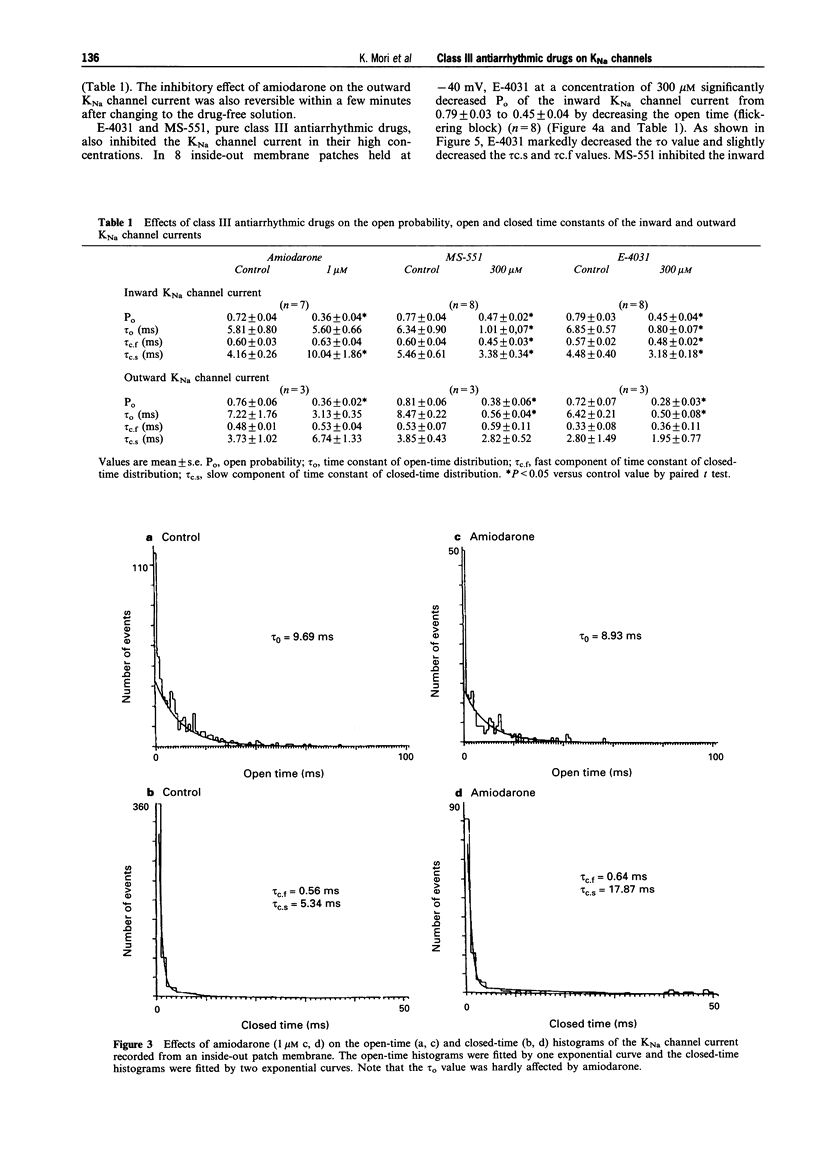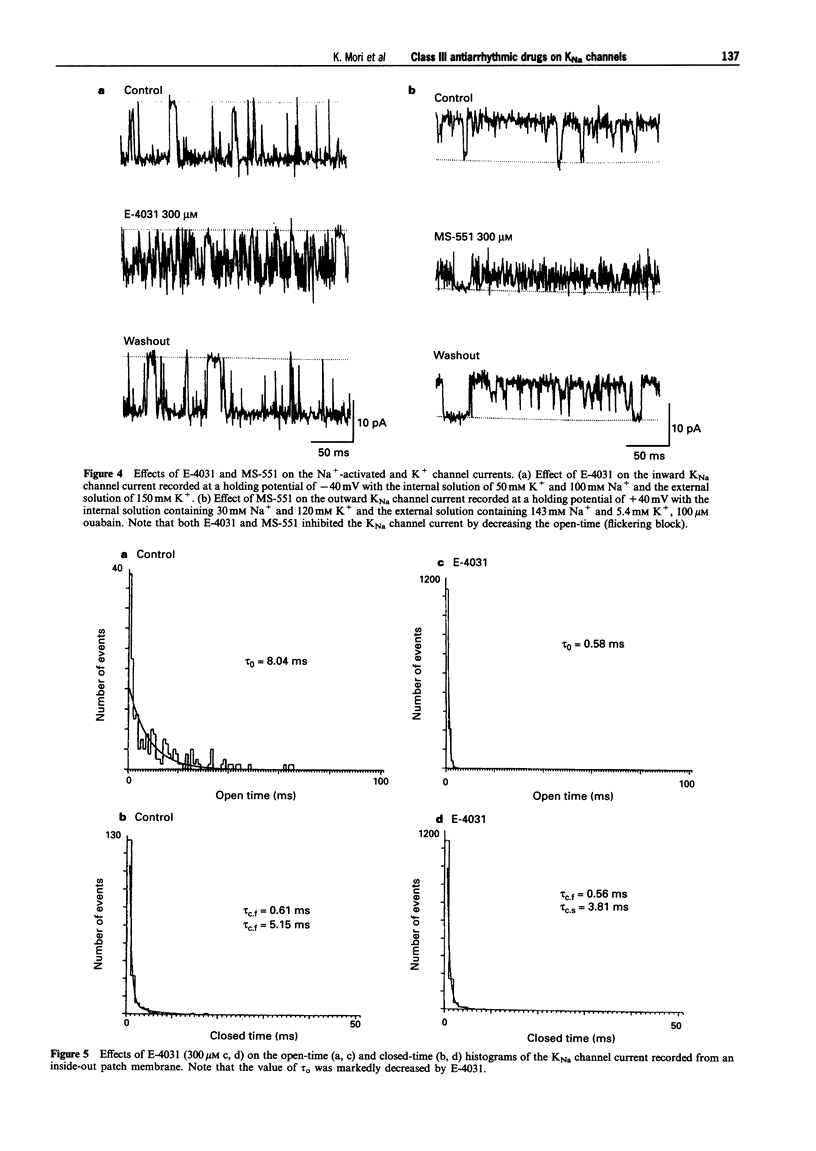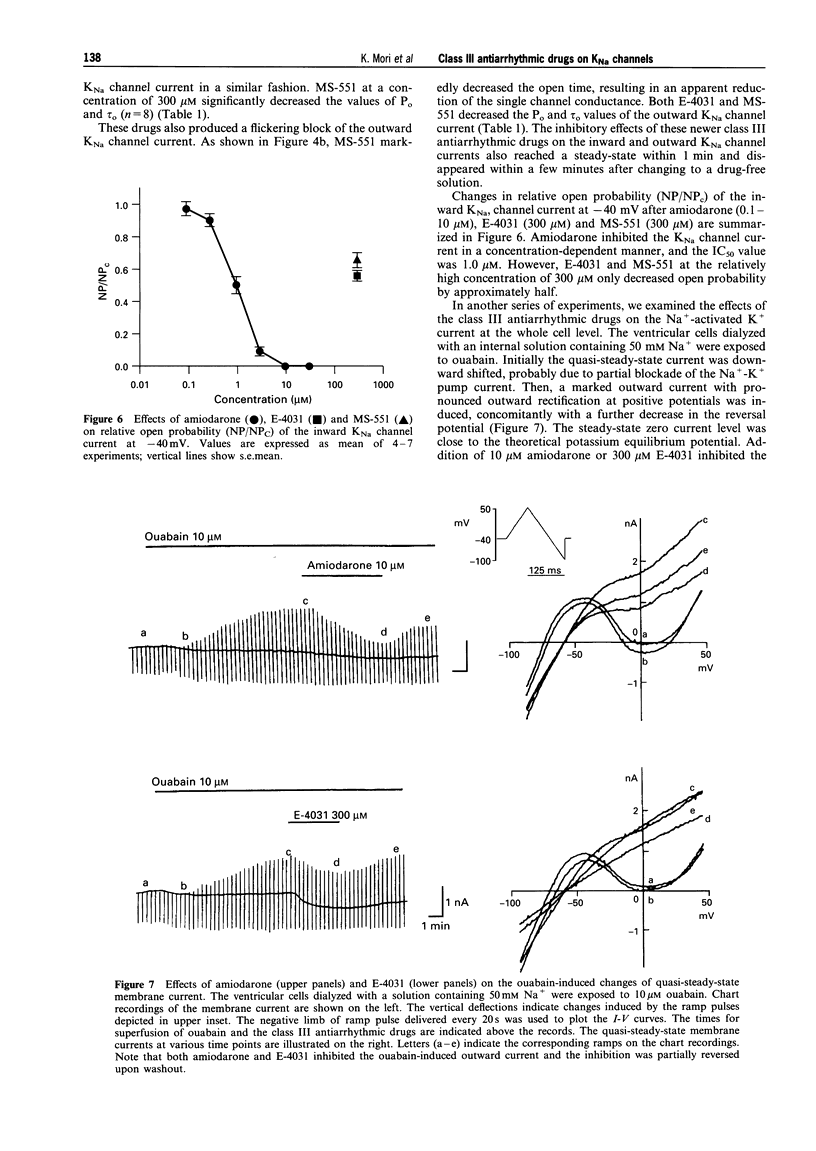Abstract
1. Class III antiarrhythmic drugs are known to block the outward currents through voltage-gated K+ channels. However, effects of class III antiarrhythmic drugs on the ligand-gated K+ channels have not been thoroughly examined. In this study effects of amiodarone and newer class III antiarrhythmic drugs, E-4031 and MS-551, on the Na+-activated K+ (KNa) current were examined in inside-out membrane patches and in whole cells isolated from guinea-pig ventricle. 2. The KNa channel current was activated by increasing [Na+]i from 0 mM to 30-100 mM with 150 mM [K+]o in inside-out membrane patches of ventricular myocytes. The channel current showed a larger slope conductance (210 pS), inward-going rectification and subconductance levels of various amplitudes. 3. E-4031 and MS-551 at high concentrations (300 microM) inhibited the K+ current by decreasing the open time (flickering block). On the other hand, amiodarone at relatively low concentrations (0.1-10 microM) inhibited the KNa channel current by decreasing the open probability rather than by decreasing the open time. The IC50 value of amiodarone for inhibiting the KNa channel current was 1.0 microM. 4. These drugs also inhibited the whole-cell outward current activated by intracellular loading of 50 mM [Na+]i and extracellular application of 10 microM ouabain. 5. These results indicate that class III antiarrhythmic drugs inhibit the KNa channel current in cardiac cells. However, there are sharp differences in the effective concentrations and the mode of inhibition between amiodarone and the newer class III antiarrhythmic drugs.
Full text
PDF








Selected References
These references are in PubMed. This may not be the complete list of references from this article.
- Anderson K. P., Walker R., Dustman T., Lux R. L., Ershler P. R., Kates R. E., Urie P. M. Rate-related electrophysiologic effects of long-term administration of amiodarone on canine ventricular myocardium in vivo. Circulation. 1989 Apr;79(4):948–958. doi: 10.1161/01.cir.79.4.948. [DOI] [PubMed] [Google Scholar]
- Carmeliet E. A fuzzy subsarcolemmal space for intracellular Na+ in cardiac cells? Cardiovasc Res. 1992 May;26(5):433–442. doi: 10.1093/cvr/26.5.433. [DOI] [PubMed] [Google Scholar]
- Colatsky T. J., Follmer C. H., Starmer C. F. Channel specificity in antiarrhythmic drug action. Mechanism of potassium channel block and its role in suppressing and aggravating cardiac arrhythmias. Circulation. 1990 Dec;82(6):2235–2242. doi: 10.1161/01.cir.82.6.2235. [DOI] [PubMed] [Google Scholar]
- Dryer S. E. Na(+)-activated K+ channels: a new family of large-conductance ion channels. Trends Neurosci. 1994 Apr;17(4):155–160. doi: 10.1016/0166-2236(94)90093-0. [DOI] [PubMed] [Google Scholar]
- Ellis D. The effects of external cations and ouabain on the intracellular sodium activity of sheep heart Purkinje fibres. J Physiol. 1977 Dec;273(1):211–240. doi: 10.1113/jphysiol.1977.sp012090. [DOI] [PMC free article] [PubMed] [Google Scholar]
- Fabiato A., Fabiato F. Calculator programs for computing the composition of the solutions containing multiple metals and ligands used for experiments in skinned muscle cells. J Physiol (Paris) 1979;75(5):463–505. [PubMed] [Google Scholar]
- Friedrichs G. S., Chi L., Gralinski M. R., Black S. C., Basler G. C., Mu D. X., Pewitt S. R., Johnson C. R., Lucchesi B. R. MS-551 protects against ventricular fibrillation in a chronic canine model of sudden cardiac death. J Cardiovasc Pharmacol. 1995 Feb;25(2):314–323. doi: 10.1097/00005344-199502000-00018. [DOI] [PubMed] [Google Scholar]
- Hamill O. P., Marty A., Neher E., Sakmann B., Sigworth F. J. Improved patch-clamp techniques for high-resolution current recording from cells and cell-free membrane patches. Pflugers Arch. 1981 Aug;391(2):85–100. doi: 10.1007/BF00656997. [DOI] [PubMed] [Google Scholar]
- Himmel H. M., Wilhelm D., Ravens U. Effects of R56865 on membrane currents in isolated ventricular cardiomyocytes of the guinea-pig. Eur J Pharmacol. 1990 Oct 9;187(2):235–240. doi: 10.1016/0014-2999(90)90010-4. [DOI] [PubMed] [Google Scholar]
- Hondeghem L. M., Snyders D. J. Class III antiarrhythmic agents have a lot of potential but a long way to go. Reduced effectiveness and dangers of reverse use dependence. Circulation. 1990 Feb;81(2):686–690. doi: 10.1161/01.cir.81.2.686. [DOI] [PubMed] [Google Scholar]
- Honjo H., Kodama I., Kamiya K., Toyama J. Block of cardiac sodium channels by amiodarone studied by using Vmax of action potential in single ventricular myocytes. Br J Pharmacol. 1991 Mar;102(3):651–656. doi: 10.1111/j.1476-5381.1991.tb12228.x. [DOI] [PMC free article] [PubMed] [Google Scholar]
- Isenberg G., Klockner U. Calcium tolerant ventricular myocytes prepared by preincubation in a "KB medium". Pflugers Arch. 1982 Oct;395(1):6–18. doi: 10.1007/BF00584963. [DOI] [PubMed] [Google Scholar]
- Kameyama M., Kakei M., Sato R., Shibasaki T., Matsuda H., Irisawa H. Intracellular Na+ activates a K+ channel in mammalian cardiac cells. Nature. 1984 May 24;309(5966):354–356. doi: 10.1038/309354a0. [DOI] [PubMed] [Google Scholar]
- Katoh H., Ogawa S., Furuno I., Sato Y., Yoh S., Saeki K., Nakamura Y. Electrophysiologic effects of E-4031, a class III antiarrhythmic agent, on re-entrant ventricular arrhythmias in a canine 7-day-old myocardial infarction model. J Pharmacol Exp Ther. 1990 Jun;253(3):1077–1082. [PubMed] [Google Scholar]
- Leatham E. W., Holt D. W., McKenna W. J. Class III antiarrhythmics in overdose. Presenting features and management principles. Drug Saf. 1993 Dec;9(6):450–462. doi: 10.2165/00002018-199309060-00008. [DOI] [PubMed] [Google Scholar]
- Lee C. O., Fozzard H. A. Activities of potassium and sodium ions in rabbit heart muscle. J Gen Physiol. 1975 Jun;65(6):695–708. doi: 10.1085/jgp.65.6.695. [DOI] [PMC free article] [PubMed] [Google Scholar]
- Leyssens A., Carmeliet E. Block of the transient inward current by R56865 in guinea-pig ventricular myocytes. Eur J Pharmacol. 1991 Apr 10;196(1):43–51. doi: 10.1016/0014-2999(91)90407-h. [DOI] [PubMed] [Google Scholar]
- Luk H. N., Carmeliet E. Na(+)-activated K+ current in cardiac cells: rectification, open probability, block and role in digitalis toxicity. Pflugers Arch. 1990 Aug;416(6):766–768. doi: 10.1007/BF00370627. [DOI] [PubMed] [Google Scholar]
- Mitani A., Shattock M. J. Role of Na-activated K channel, Na-K-Cl cotransport, and Na-K pump in [K]e changes during ischemia in rat heart. Am J Physiol. 1992 Aug;263(2 Pt 2):H333–H340. doi: 10.1152/ajpheart.1992.263.2.H333. [DOI] [PubMed] [Google Scholar]
- Mori K., Hara Y., Saito T., Masuda Y., Nakaya H. Anticholinergic effects of class III antiarrhythmic drugs in guinea pig atrial cells. Different molecular mechanisms. Circulation. 1995 Jun 1;91(11):2834–2843. doi: 10.1161/01.cir.91.11.2834. [DOI] [PubMed] [Google Scholar]
- Nakaya H., Hattori Y., Tohse N., Shida S., Kanno M. Beta-adrenoceptor-mediated depolarization of the resting membrane in guinea-pig papillary muscles: changes in intracellular Na+, K+ and Cl- activities. Pflugers Arch. 1990 Oct;417(2):185–193. doi: 10.1007/BF00370698. [DOI] [PubMed] [Google Scholar]
- Nakaya H., Tohse N., Takeda Y., Kanno M. Effects of MS-551, a new class III antiarrhythmic drug, on action potential and membrane currents in rabbit ventricular myocytes. Br J Pharmacol. 1993 May;109(1):157–163. doi: 10.1111/j.1476-5381.1993.tb13546.x. [DOI] [PMC free article] [PubMed] [Google Scholar]
- Neher E., Steinbach J. H. Local anaesthetics transiently block currents through single acetylcholine-receptor channels. J Physiol. 1978 Apr;277:153–176. doi: 10.1113/jphysiol.1978.sp012267. [DOI] [PMC free article] [PubMed] [Google Scholar]
- Sanguinetti M. C., Jurkiewicz N. K. Two components of cardiac delayed rectifier K+ current. Differential sensitivity to block by class III antiarrhythmic agents. J Gen Physiol. 1990 Jul;96(1):195–215. doi: 10.1085/jgp.96.1.195. [DOI] [PMC free article] [PubMed] [Google Scholar]
- Singh B. N., Sarma J. S., Zhang Z. H., Takanaka C. Controlling cardiac arrhythmias by lengthening repolarization: rationale from experimental findings and clinical considerations. Ann N Y Acad Sci. 1992 Jan 27;644:187–209. doi: 10.1111/j.1749-6632.1992.tb31011.x. [DOI] [PubMed] [Google Scholar]
- Singh B. N., Vaughan Williams E. M. The effect of amiodarone, a new anti-anginal drug, on cardiac muscle. Br J Pharmacol. 1970 Aug;39(4):657–667. doi: 10.1111/j.1476-5381.1970.tb09891.x. [DOI] [PMC free article] [PubMed] [Google Scholar]
- Tande P. M., Bjørnstad H., Yang T., Refsum H. Rate-dependent class III antiarrhythmic action, negative chronotropy, and positive inotropy of a novel Ik blocking drug, UK-68,798: potent in guinea pig but no effect in rat myocardium. J Cardiovasc Pharmacol. 1990 Sep;16(3):401–410. doi: 10.1097/00005344-199009000-00008. [DOI] [PubMed] [Google Scholar]
- Tohse N., Nakaya H., Kanno M. Alpha 1-adrenoceptor stimulation enhances the delayed rectifier K+ current of guinea pig ventricular cells through the activation of protein kinase C. Circ Res. 1992 Dec;71(6):1441–1446. doi: 10.1161/01.res.71.6.1441. [DOI] [PubMed] [Google Scholar]
- Tsien R. Y., Rink T. J. Neutral carrier ion-selective microelectrodes for measurement of intracellular free calcium. Biochim Biophys Acta. 1980 Jul;599(2):623–638. doi: 10.1016/0005-2736(80)90205-9. [DOI] [PubMed] [Google Scholar]
- Wang Z., Kimitsuki T., Noma A. Conductance properties of the Na(+)-activated K+ channel in guinea-pig ventricular cells. J Physiol. 1991 Feb;433:241–257. doi: 10.1113/jphysiol.1991.sp018424. [DOI] [PMC free article] [PubMed] [Google Scholar]
- Wendt-Gallitelli M. F., Voigt T., Isenberg G. Microheterogeneity of subsarcolemmal sodium gradients. Electron probe microanalysis in guinea-pig ventricular myocytes. J Physiol. 1993 Dec;472:33–44. doi: 10.1113/jphysiol.1993.sp019934. [DOI] [PMC free article] [PubMed] [Google Scholar]
- Wilhelm D., Himmel H., Ravens U., Peters T. Characterization of the interaction of R 56865 with cardiac Na- and L-type Ca channels. Br J Pharmacol. 1991 Oct;104(2):483–489. doi: 10.1111/j.1476-5381.1991.tb12455.x. [DOI] [PMC free article] [PubMed] [Google Scholar]


